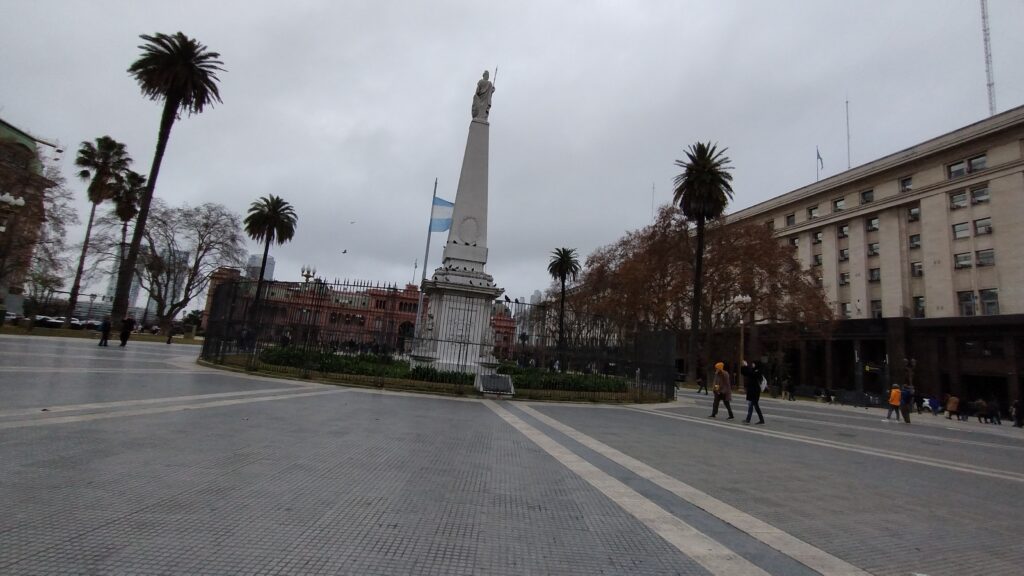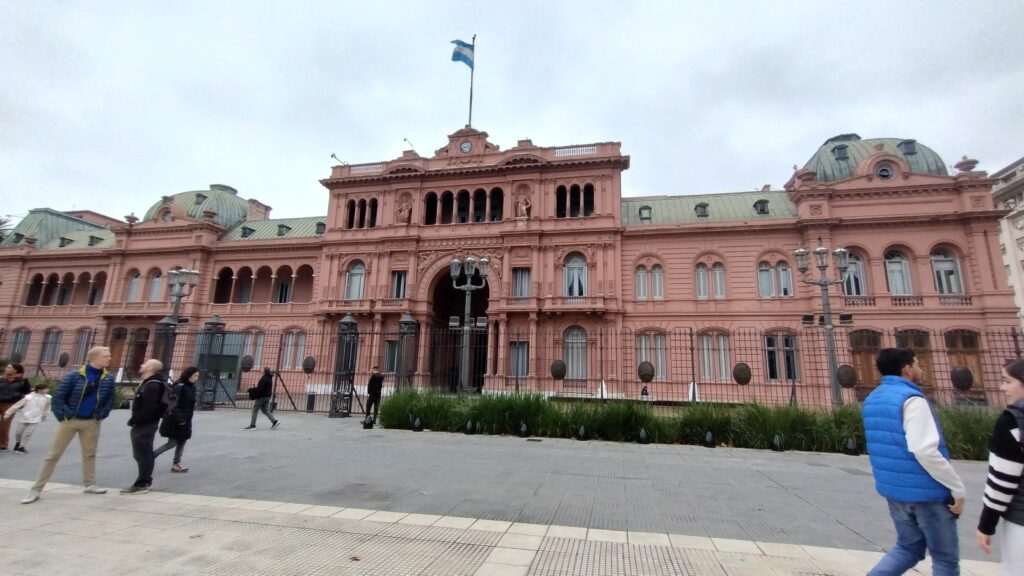If we refer to Buenos Aires, there are a number of places that are familiar even to the most “ignorant”. For example, the Plaza de Mayo, the place where the most important events in Argentine history took place.
Visiting the Plaza de Mayo is like being on a battlefield where important events took place and where traces of the past still exist.
Here we tell you everything about the Plaza de Mayo: where it is located, what its history is and what you can do to capture the full weight of its political, cultural and historical significance.
Plaza de Mayo (Buenos Aires): Everything You Need to Know Before Your Visit
What is Plaza de Mayo?
Plaza de Mayo is the most politically, symbolically, and historically significant site in Buenos Aires and Argentina, comparable to the National Congress. Established in 1884 by merging two existing plazas, it is located on the very spot where the city was refounded in 1580.
Situated in the Monserrat neighborhood, Plaza de Mayo is surrounded by important buildings and monuments with immense historical value, including the presidential palace, known as the Casa Rosada. The plaza also serves as a key urban and transportation hub, with subway stations for Lines A, D, and E located beneath its two hectares.
Plaza de Mayo frequently hosts popular demonstrations, events, and political rallies. Its landscape has evolved over time, reflecting the country’s changing political and social climate. The plaza is named in honor of the May Revolution of May 25, 1810, which took place in this very square and marked the beginning of Argentina’s fight for independence from Spain.
In the center of the plaza stands the Pirámide de Mayo, a monument built in 1811 to celebrate the first anniversary of the revolution, later redesigned in 1856 by artist and architect Prilidiano Pueyrredón. Between the Pirámide de Mayo and the Casa de Gobierno, you’ll also find the monument to Manuel Belgrano, the creator of the national flag.
Plaza de Mayo features lighting, benches, water fountains, solar-powered clocks, and a flagpole with the Argentine flag. Additionally, there are trees and the entrance to the Line A subway station.
Historical Events at Plaza de Mayo
- 1580: Buenos Aires refounded by Juan de Garay.
- 1760: Celebrations for the proclamation of King Charles III of Spain.
- 1806-1807: British invasions and battles against British troops.
- 1810: May Revolution.
- 1816: Celebration of the declaration of independence in the Congress of Tucumán.
- 1882: Tribute to the death of Italian revolutionary Giuseppe Garibaldi.
- 1890: First political march by the Unión Cívica after its founding as a political party.
- 1910: Celebrations of the centenary of the May Revolution.
- 1920: Tributes marking the centenary of General Manuel Belgrano’s death.
- 1945: Popular demonstration demanding the release of Colonel Perón, a day remembered as Loyalty Day (October 17).
- 1955: Bombing of Plaza de Mayo by the Argentine Naval Aviation as part of a coup attempt, resulting in 300 civilian deaths and numerous injuries, preluding the Revolución Libertadora against Perón.
- 1977: The beginning of the Mothers of Plaza de Mayo meetings to demand answers about those who disappeared during the military dictatorship.
- 1982: The military government announces plans to reclaim the Falkland Islands (Malvinas). The subsequent defeat spurred other protests against the dictatorship.
- 1983: Celebration of the return of democracy.
- 1984: Popular mobilization accompanying the delivery of the Nunca Más report to President Alfonsín. This report, organized by the National Commission on the Disappearance of Persons, documents the investigations into disappearances, torture, and murder by the military dictatorship and paramilitary organizations.
- 1987: Celebration of the end of the military insurrection against the Alfonsín government.
- 2001: Social unrest during President De La Rúa’s administration. Police repression and deaths contributed to the president’s resignation, marked by his escape via helicopter from the government palace’s rooftop.
- 2013: Celebrations following the election of Argentine Jorge Bergoglio as Pope Francis.

Where is Plaza de Mayo?
Plaza de Mayo is located in the Monserrat neighborhood, within Comuna 1 of Buenos Aires. It is situated in the area known as the microcentro, surrounded by Hipólito Yrigoyen, Balcarce, Avenida Rivadavia, and Bolívar streets.
On the west side of Plaza de Mayo, you’ll find major avenues like Julio A. Roca, Roque Sáenz Peña, and Avenida de Mayo. The area surrounding the plaza is home to significant monuments and points of interest, such as the Cabildo, Casa Rosada, and the Metropolitan Cathedral.
This part of Buenos Aires is the epicenter of the most popular demonstrations and has been the stage for crucial national political events. To the north of Plaza de Mayo are avenues Corrientes, Córdoba, and Santa Fe, as well as the Retiro neighborhood. To the east is the modern Puerto Madero district, and to the west, you can reach Avenida 9 de Julio, beyond which lies the Balvanera neighborhood. To the south is the San Telmo neighborhood, and further south, La Boca.
How to Get to Plaza de Mayo?
The quickest way to reach Plaza de Mayo is by subway. As a central hub or transfer point for several subway lines (A, D, and E), this mode of transportation is the best option for getting to the plaza and moving on to other areas of Buenos Aires.
Several bus lines also pass near Plaza de Mayo, making them another fast and economical way to get there. Some of these bus lines include 8, 24, 28, 29, 86, 105, 111, 126, and 195.
The area is not recommended for private cars, especially on weekdays, due to the heavy foot and vehicle traffic. On weekends, you can opt for private cars or bicycles, but be sure to find a private parking lot for your vehicle.

Why Visit Plaza de Mayo?
Explore the Most Important Plaza in Buenos Aires
Plaza de Mayo is steeped in symbolic and historical significance, setting it apart from other plazas in the city. It has been the site of many of the most important events in the history of Buenos Aires and Argentina.
Walking through the two hectares of Plaza de Mayo is like taking a journey through time, witnessing the events that shaped not only the plaza but also the destiny of Argentina and Buenos Aires.
Visit Museums and Historic Sites Around the Plaza
The historic core of Buenos Aires centers around Plaza de Mayo. From the Cabildo to the Casa Rosada, many of the buildings surrounding the plaza are must-see tourist attractions, offering a more comprehensive understanding of the area’s history and symbolism.
Whether you head south, north, or west from Plaza de Mayo, you’ll find buildings with unmistakably European architecture as well as modern structures. Each corner of the Buenos Aires city center holds secrets and stories waiting to be discovered.
Enjoy a Coffee with the Aroma of Buenos Aires
For travelers, there’s nothing better than enjoying a coffee near Plaza de Mayo. Numerous historic cafés are located in the area, many of which were frequented by important political and cultural figures.
Continue Your Tour Beyond Plaza de Mayo
Your sightseeing tour in this part of Buenos Aires shouldn’t end at Plaza de Mayo. In every direction, taking Plaza de Mayo as your starting point, there are places worth exploring. So, it’s ideal to take advantage of your visit to Plaza de Mayo to complete a more comprehensive tour without the need for long walks or extensive travel.


